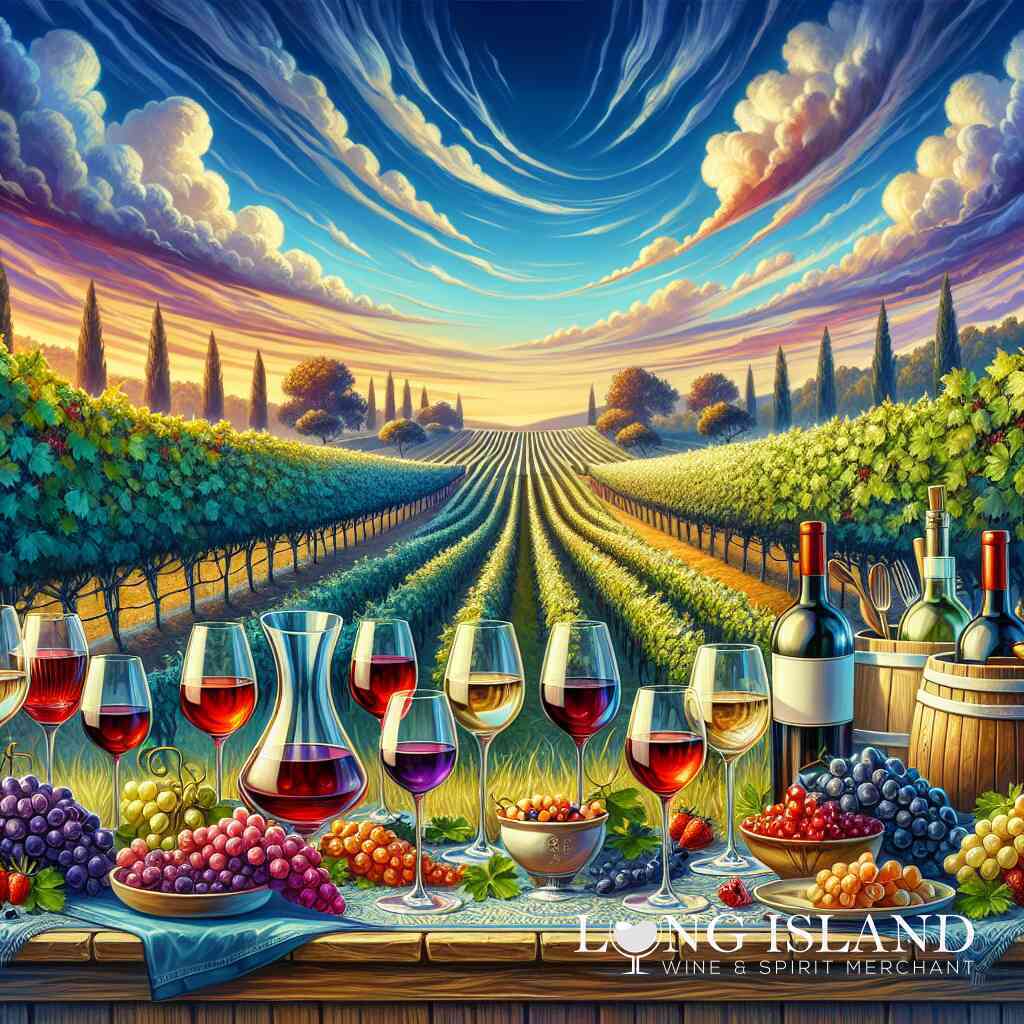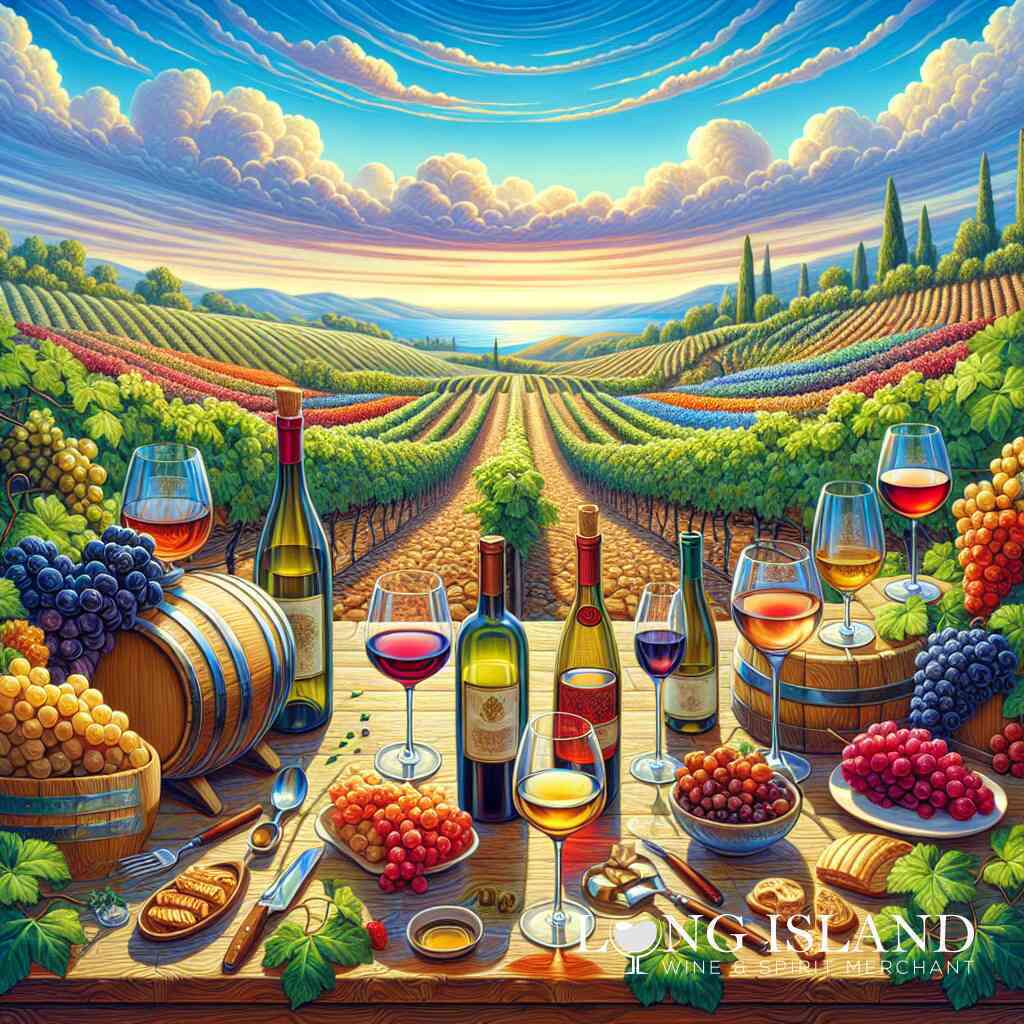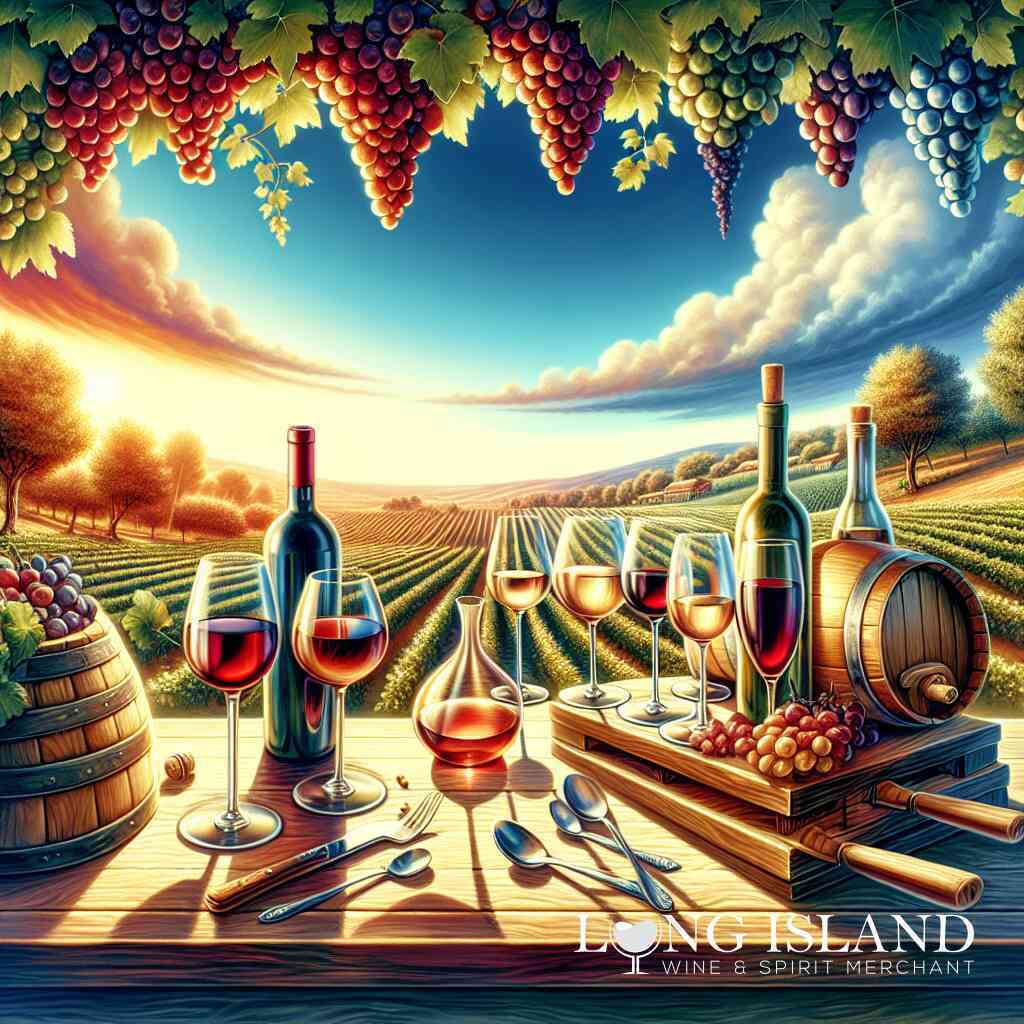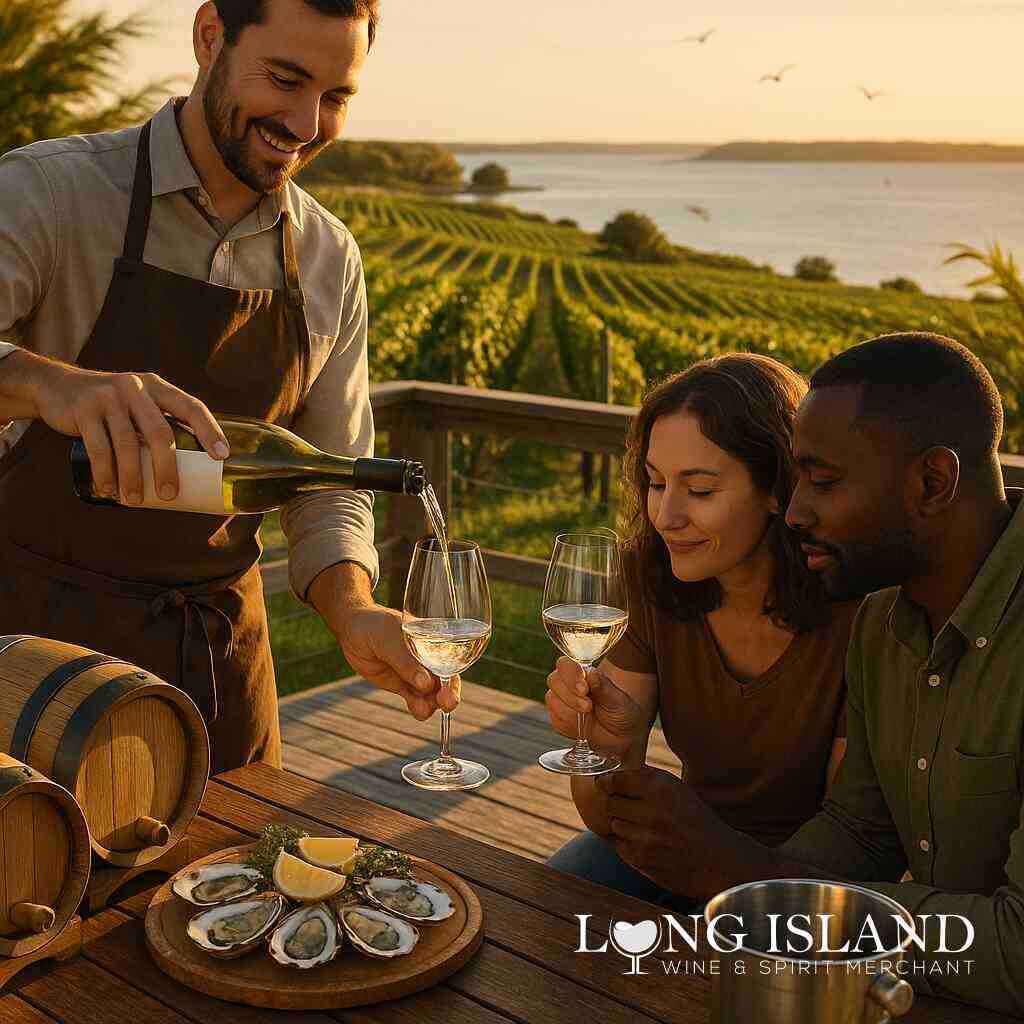
The Difference Between Red and White Wine
July 16, 2024
Uncorking the Basics
Definition and Overview
Wine, a cherished beverage celebrated across the globe, emerges from the fermentation of crushed grapes, harnessing the magical interplay of yeast and sugar to birth alcohol. This process, steeped in tradition and modern innovation, yields two predominant wine types: red and white. The distinction between red and white wine is not merely a question of color but involves differences in grape varieties, vinification methods, and flavor profiles. Red wines, known for their bold hues ranging from deep purples to rich garnets, are typically made from red or black grapes and retain their skins during fermentation. White wines, on the other hand, are produced from white grapes and sometimes red grapes with their skins removed, resulting in lighter, golden tones. Each type offers a distinct sensory experience, from the tannic structure of reds to the crisp acidity of whites, making wine a versatile accomplice to a myriad of gastronomical delights.
History of Wine
The saga of wine stretches back thousands of years, with its roots intricately woven into the fabrics of ancient civilizations. Evidence suggests the earliest winemaking activities occurred around 6000 BC in regions now known as Georgia and Iran, where the wild grapevine Vitis vinifera was first domesticated. Through the millennia, wine traversed continents and cultures, evolving from a simple fermented beverage into a symbol of social status, religious ritual, and artistic inspiration. The Greeks and Romans extensively cultivated wine, refining its production and storage and embedding it deeply in their societal norms and mythology. The Middle Ages saw the preservation and expansion of winemaking knowledge by monasteries across Europe, setting the stage for the diverse and rich wine culture that flourishes globally today. From ancient amphorae to the sophisticated wine cellars of the modern era, wine’s journey mirrors humanity’s own, marked by innovation, expansion, and an unwavering appreciation for the finer indulgences in life.
Wine Tasting Essentials
Wine tasting, an art honed over centuries, offers an immersive pathway to understanding and appreciating wine’s complexity. It engages the senses, allowing one to dissect the nuanced layers of flavor, aroma, and texture present in each glass. The essentials of wine tasting encompass seeing, swirling, smelling, sipping, and savoring. Initially, examining the wine’s color and clarity can provide preliminary insights into its age and grape varietal. Swirling aerates the wine, unlocking a bouquet of aromas that hint at its origins, winemaking process, and storage conditions. The act of smelling introduces the olfactory system to a spectrum of fruit, floral, earthy, and spicy notes while sipping invites the palate to explore wine’s body, acidity, sweetness, and tannins. Finally, savoring encapsulates the entire experience, encouraging a reflective appreciation of the wine’s aftertaste and its lingering impression. To elevate this sensory journey, engaging in a wine-tasting quiz can sharpen one’s palate and deepen one’s understanding of personal taste preferences, guiding one’s future selections from vineyard to glass.
Vine to Glass
Red Wine Production
The journey of red wine from vineyard to bottle is a meticulous process that begins with the selective harvesting of red or black grape varieties, carefully chosen for their ripeness and flavor potential. Unlike white wine, during red wine production, the skins, seeds, and sometimes stems are left in contact with the grape juice during fermentation, a crucial step that imparts the signature color, tannins, and complex flavors associated with red wine. Modern winemakers might control temperature and employ various fermentation techniques to enhance the wine’s character, aiming for a perfect balance between depth of flavor and approachable smoothness. Once fermentation is complete, red wines often undergo a secondary fermentation process called malolactic fermentation, which softens the wine and adds to its texture before it’s aged in oak barrels, further developing its intricate flavors and aroma profile.
White Wine Production
White wine production takes a lighter touch compared to its red counterpart, focusing on preserving the grape’s natural aromatics and freshness. The process starts with pressing white grapes, although in some cases, red grapes can also be used to make white wine, provided their skins are promptly removed to avoid any color transfer. The juice is then cooled and clarified, removing any solid particles to ensure the final product’s clarity and smoothness. Fermentation follows, typically at lower temperatures than those used for red wines, to retain the delicate floral and fruity notes characteristic of white wines. Some white wines may undergo oak aging to add complexity and richness, but many are bottled relatively young to emphasize their vibrant acidity and crisp character.
Skin Contact Fermentation
Skin contact fermentation, also known as maceration, plays a pivotal role in determining the color, taste, and texture of wine. This process, particularly central to red wine production, involves letting the crushed grape skins soak in their juice for a period ranging from a few days to several weeks. This not only transfers the pigments known as anthocyanins into the wine, giving it its red color, but also allows tannins and flavor compounds to infuse the liquid, adding body, structure, and depth. In making orange wines, a white wine style where white grape skins are left in contact with the juice contact, fermentation imbues the wine with a distinctive amber hue and a complex, robust profile not typically found in traditional white wines.
Fermentation Process
The fermentation process is the transformative stage that turns grape juice into wine, governed by the action of yeast cells converting sugars into alcohol and carbon dioxide. This metabolic process can occur naturally or be encouraged by adding cultured yeasts, with winemakers closely monitoring temperature, pH levels, and fermentation speed to influence the wine’s development. During fermentation, numerous compounds that contribute to the wine’s aroma and flavor profile are also created or released, showcasing the importance of this phase in crafting the wine’s identity. Whether for red, white, or rosé, the fermentation process is a delicate balance of science and art, with variables carefully adjusted to achieve the desired outcome, a testament to the skill and intuition of winemakers in shaping the essence of their wines. A deeper understanding of fermentation in winemaking reveals the complexity and craftsmanship behind every bottle, echoing the meticulous care from vine to glass.
Breaking Down the Bottle
Wine Grape Varieties
Diving deeper into the realm of wines begins with understanding the vast array of grape varieties cultivated around the world, each with a unique profile contributing to the tapestry of wine flavors and textures. Red wine grape varieties, such as Cabernet Sauvignon, Merlot, and Pinot Noir, are celebrated for their rich color and complex flavor profiles, ranging from luscious berry notes to compelling earthy undertones. In contrast, white wine grape varieties like Chardonnay, Sauvignon Blanc, and Riesling charm palates with their light, airy profiles, marked by crisp citrus and floral hints. Long Island, a haven for wine connoisseurs, boasts an exclusive fine wine selection featuring a curated assortment of both red and white wines that showcase the best of these grape varieties. Exploring these different grapes unlocks the stories behind each bottle, revealing the influence of terroir, climate, and winemaking techniques on the final product.
Wine Color Meaning
The hue of a wine offers the first visual clue about its style, age, and flavor profile. Red wines, thanks to the skin contact method during fermentation, exhibit a spectrum from pale ruby to deep garnet. Younger reds tend to have brighter tones, whereas mature wines develop more profound, more intense colors. White wines, on the other hand, can range from the faintest straw to rich gold, often reflecting the grape variety, aging process, and winemaking methods employed. Interestingly, the color of the wine can also hint at its geographical origin, as some regions are known for producing wines with characteristic shades, underscoring the intricate dance between nature and nurture in winemaking.
Tannins in Wine
Tannins, natural compounds found in grape skins, seeds, and stems, play a pivotal role in the structure and flavor profile of red wines. These compounds impart a sensation of dryness in the mouth, contributing to the body, complexity, and age-ability of the wine. Tannins act as a natural preservative, allowing red wines to mature gracefully over time, developing richer, smoother profiles. The level of tannins in wine can vary greatly depending on factors such as grape variety, winemaking techniques, and aging processes, making them a fascinating element for exploration by enthusiasts seeking to deepen their understanding of wine’s diverse palette.
Wine Body
The term “body” in wine describes its weight and fullness on the palate, influenced by a combination of factors, including alcohol content, sugar level, and concentration of flavors. Wines can be classified as light, medium, or full-bodied, offering a broad spectrum of sensory experiences. Light-bodied wines, typically white varieties, are characterized by their refreshing, delicate mouthfeel, making them perfect for warmer weather or as aperitifs. Medium-bodied wines serve as a versatile middle ground. In contrast, full-bodied wines, such as many reds, boast a rich, robust presence that commands attention and pairs wonderfully with hearty dishes. Understanding the body of wine aids in selecting the perfect bottle for any occasion, enhancing the culinary journey.
Wine Acidity
Acidity in wine refers to the fresh, tart, and crisp qualities that invigorate the palate. It’s a cornerstone of balance in winemaking, influencing the wine’s freshness, structure, and longevity. High-acidity wines, often white, are celebrated for their vibrancy and ability to pair well with a wide array of foods, cutting through more decadent flavors with grace. Red wines with balanced acidity contribute to their complexity and charm, ensuring the wine remains lively and engaging over time. The level of acidity in wine can significantly impact its taste, mouthfeel, and overall appeal, making it a crucial component in the winemaker’s toolkit for crafting memorable and harmonious wines.

From Barrel to Best Enjoyed
Wine Aging
Wine aging represents a transformative journey, a guided evolution under the watchful eye of time and tradition, designed to unveil the depth and complexity capable of a bottle of wine. It’s in this phase that both red and white wines can develop nuanced flavors and aromas not present at the time of bottling. Red wines, rich in tannins, are particularly well-suited to extended aging, gradually softening and integrating their more astringent components into a harmonious whole. White wines, especially those with a highly acidic backbone, also age gracefully, developing rich, complex notes that echo butterscotch, honey, and nuts. Through the aging process, wines are slowly oxidized, a controlled exposure to oxygen that evolves and elevates the wine’s character from simple fruitiness to profound depths of flavor, embodying the essence of wine aging and its significance in crafting world-renowned vintages.
Wine Storage
Proper wine storage is crucial for maintaining the integrity and optimizing the aging potential of wine. Ideal conditions include a stable, cool temperature, around 55°F (13°C), with a humidity level of about 70% to prevent the cork from drying out. Exposure to light, particularly UV rays, should be minimized as it can lead to premature aging and degradation of the wine. Additionally, wines are best stored horizontally to keep the liquid in contact with the cork, ensuring it remains expanded and airtight. Whether it’s a state-of-the-art wine cellar or a specialized wine refrigerator, the correct storage conditions help to preserve wine’s complexity, nuances, and flavors, ensuring it reaches its full potential. Interestingly, even in urban areas like Commack, New York, wine enthusiasts can find innovative solutions for wine storage, from customized cellars to professional storage facilities catering to the needs of every collector.
Wine Aerating and Decanting
The practices of wine aerating and decanting serve as an invitation to wine, coaxing it to reveal its full array of aromas and flavors. Aerating wine by exposing it to air drives off more volatile compounds that can mask more delicate, desirable nuances. This is especially beneficial for younger red wines, which often carry a certain harshness from tannins or sulfites. Decanting, on the other hand, is a delicate process of slowly pouring wine from its bottle into a decanter, leaving any sediment behind. This not only clarifies the wine but also allows it to breathe, opening up its character and softening its palate. Together, aerating and decanting enhance the overall sensory experience of wine, making them essential rituals for serious aficionados aiming to unlock the complete pleasure hidden within each pour.
Wine Serving Temperature
The temperature at which wine is served can significantly influence its aroma, flavor, and overall drinking experience. Red wines typically benefit from being served slightly below room temperature, between 62°F to 68°F (16°C to 20°C), allowing their complex flavors to shine without being overshadowed by alcohol heat. White wines, on the other hand, are best appreciated when chilled, around 49°F to 55°F (9°C to 13°C), which highlights their crispness, acidity, and fruitiness. Sparkling wines and rosés fall within the more astonishing spectrum as well, ensuring their refreshing qualities are foremost. This nuanced approach to serving temperature showcases the importance of understanding and respecting the delicate balance each wine demands, underlining the intricate interplay between wine and its conditions of enjoyment. This focused attention ensures that from Long Island premier wines and spirits to international selections, every bottle served is an invitation to a journey of discovery tailored to taste in its ideal state.
Pairing and Sipping
Wine Pairing
Wine pairing is the art of matching wine with dishes to enhance the dining experience, a practice that can elevate a simple meal to a memorable gustatory event. The fundamental principle of wine pairing is to balance flavors, where the wine complements or contrasts the food in a way that accentuates the qualities of both. For example, the classic pairing of Cabernet Sauvignon with a robust steak utilizes the tannins in the wine to cut through the fat of the meat, enhancing the richness of both the dish and the drink.
Developing an adeptness for wine pairing involves understanding the characteristics of different wines, from a dry white wine’s crisp acidity that can brighten seafood’s delicate flavors to a sweet red wine’s lush sweetness that can counterbalance the heat of spicy dishes. Notably, on Long Island, where the culinary scene is as diverse as its wine selections, exploring local pairings can lead to delightful discoveries. Whether dining at a waterfront restaurant or hosting a cozy dinner party at home, incorporating Long Island wine into your meal can transform local ingredients into a celebration of regional flavor.
Wine Selection from Our Wine Rack to Your Wine Glass
At Long Island Wine & Spirit Merchant, we understand that browsing through our curated wine selection can be both exciting and daunting. We aim to bridge the gap between our expertly selected wines and your taste, ensuring that what moves from our wine rack finds a perfect spot in your wine glass. Discovering the right bottle-be it for a special occasion, a gift, or to enjoy with dinner-is made easier with our knowledgeable staff ready to guide you through our extensive inventory. From the finest dry red wines that Long Island has to offer to exquisite varieties of white wine, our selection caters to connoisseurs and casual sippers alike.
Our team takes pride in presenting a portfolio that encompasses both local Long Island wines and international gems, ensuring that each visit to our store or website introduces you to something new and exciting. For those looking to explore without leaving the comfort of their home, our alcohol delivery service ensures that your next favorite wine is just a click away.
Wine and Food Matching
The culmination of any wine and food-matching endeavor should be the harmonious blending of flavors, where the elements of each pairing enhance one another. When considering wine and food combinations, it’s helpful to think beyond the simple red-with-meat, white-with-fish rule. Think about the dominant flavors of the dish and the wine-acidic, fatty, sweet, or spicy-and how these can complement or contrast with each other.
For instance, the vibrant acidity in a Sauvignon Blanc can complement the richness of creamy seafood pasta. At the same time, the subtle sweetness of a Riesling makes it an ideal counterpart for spicy Asian cuisine. On the other hand, a robust Long Island red wine, such as Merlot or Cabernet Franc, might be paired with earthy flavors found in mushroom risotto or a hearty beef stew, showcasing the wine’s complexity against the savory depth of the dish.
Wine and food matching, while rooted in some guiding principles, ultimately relies on personal preference and the willingness to experiment. Engaging in wine-tasting events, like those hosted by Long Island Wine & Spirit Merchant, offers a splendid opportunity to explore various pairings in a guided setting. These events help refine your palate and discover pairings that resonate with your unique taste. Through experience and exploration, the perfect wine and food match can elevate the dining experience from ordinary to extraordinary, creating moments and memories to savor.
A Deeper Day
Sulfites in Wine
Sulfites are a group of sulfur-based compounds naturally occurring in wine and are also added as preservatives to prevent oxidation and maintain a wine’s freshness. Although sulfites are present in nearly all wines, their level can vary significantly. For those with sulfite sensitivities or preferences for wines with minimal intervention, understanding the sulfite content in wine is crucial. Sulfites help preserve the wine’s character and longevity, but the move towards organic winemaking practices has seen a rise in wines made with lower sulfite levels. By carefully selecting the right bottle, wine enthusiasts can enjoy a glass that aligns with their health preferences and dietary needs without compromising on quality or experience.
Wine Health Benefits
For centuries, wine has been celebrated not just for its taste and sociability but also for its health benefits when consumed in moderation. Studies have indicated that moderate wine consumption, particularly red wine, can contribute to heart health due to its high content of antioxidants like flavonoids and resveratrol. These compounds are thought to reduce the risk of heart disease by increasing the levels of good cholesterol (HDL) and protecting against artery damage. While the health benefits of wine suggest a compelling reason to enjoy a glass, it’s essential to balance with a healthy lifestyle for the most positive impact.
Terroir Influence on Wine
Terroir, a French term without a precise English equivalent, refers to the unique combination of natural factors, including soil, climate, and topography, that gives wine grapes their distinct character. This concept embodies the essence of the wine’s origin, influencing everything from aroma and flavor to texture and color. By understanding the terroir of different wine regions, connoisseurs can appreciate the diverse expressions of wines, even those made from the same grape varietal. Long Island, with its distinct maritime climate and rich glacial soils, presents an excellent example of how terroir can shape the profile of wines, offering a unique experience in each bottle.
Wine Regions Exploration
The world is dotted with iconic wine regions, each boasting its unique heritage, grape varietals, and winemaking traditions. From the rolling hills of Tuscany and the rugged landscapes of Bordeaux to the sun-drenched valleys of Napa and the maritime influence of Long Island, wine regions offer a passport to a world of flavors. Exploring these regions, whether through travel or the tasting glass, allows enthusiasts to delve deeper into the nuanced world of wine. Engaging with the stories behind the wine, understanding the impact of regional terroir, and discovering local winemaking techniques enrich the tasting experience, turning each sip into a journey through some of the world’s most picturesque and storied landscapes.

The Long Island Wine and Spirit Merchant Touch
Discovering the Wine Flavor Profiles
At Long Island Wine & Spirit Merchant, we pride ourselves on guiding each customer through the vast world of wine, helping them discover the unique flavor profiles that resonate most with their palate. Whether you prefer the bold, complex notes of dry red wine or the light, refreshing qualities of a crisp white, our selection is designed to cater to every taste and occasion. With a passion for education and a commitment to excellence, we offer personalized recommendations and tasting events that aim to expand your wine knowledge and appreciation. From our wine rack to your wine glass, we ensure that every sip is a journey of discovery.
Exclusive Fine Wine and Good Spirits Selection
Long Island Wine & Spirit Merchant stands out with an exclusive selection of fine wines and good spirits that cater to both connoisseurs and casual drinkers alike. Our carefully curated collection features everything from locally sourced Long Island wines to rare finds from across the globe, ensuring that each customer finds their perfect match. Our dedication to quality and variety is reflected in our offerings, with particular attention to artisanal and small-batch producers who share our passion for craftsmanship and flavor. Whether you’re seeking a bottle for a special occasion or looking to explore new tastes, our exclusive fine wine and good spirits selection promises to exceed your expectations.
Unique Services: Wine Bottle Engraving and Custom Case of Wine
To enhance your wine experience, Long Island Wine & Spirit Merchant offers unique services like wine bottle engraving and the option to create a custom wine case. Our wine bottle engraving service adds a personal touch to any gift or occasion, turning an ordinary bottle into a cherished keepsake. For those looking to diversify their wine collection or prepare for an event, our custom case creation allows you to handpick a selection of wines tailored to your preferences and needs. These services are a testament to our commitment to providing not just quality products but memorable experiences.
Wine Taste Quiz to Match Your Palate
At Long Island Wine & Spirit Merchant, we understand that the wide world of wine can be overwhelming, especially when trying to find those that best match your taste. That’s why we’ve designed a unique wine taste quiz to help streamline your selection process. By answering a few simple questions about your flavor preferences and wine-drinking habits, we can recommend wines from our vast selection that align with your palate. This personalized approach ensures that you discover new favorites and revisit beloved classics, all tailored to your taste.
Alcohol Delivery Near Me for Your Convenience
In today’s fast-paced world, convenience is vital. Long Island Wine & Spirit Merchant is proud to offer an alcohol delivery service near me that brings your favorite wines and spirits straight to your doorstep. Whether you’re hosting a last-minute gathering or prefer the ease of at-home shopping, our delivery service covers all 50 states in the US, with fast local delivery options available on Long Island. With just a few clicks, you can browse our selection, place your order, and relax, knowing that your wine and spirits will arrive safely and swiftly, ready for your enjoyment.
At Long Island Wine & Spirit Merchant, we are dedicated to elevating your wine and spirits experience. From discovering new flavor profiles to enjoying the convenience of home delivery, we are here to serve you every step of the way. Welcome to our world of fine wine and good spirits, where every bottle tells a story, and every sip is an adventure.
Frequently Asked Questions
Question: What factors influence the flavor profiles of red wine vs white wine?
Answer: The flavor profiles of red and white wines are influenced by several key factors, starting from the specific grape varieties used. Red wines, crafted from red or black grapes and undergoing fermentation with the grape skins, gain their rich, complex flavors and tannins from this process, offering deeper, sometimes spicier notes such as berries, cherries, and oak. White wines, made by fermenting the juice of white grapes or red grapes with skins removed, typically exhibit lighter, crisper flavor profiles with hints of citrus, apple, peach, or tropical fruits. Additionally, the fermentation process, including whether the wine is aged in oak or stainless steel, and the terroir- the unique combination of climate, soil, and topography of the vineyard- also significantly affect a wine’s character. At Long Island Wine & Spirit Merchant, we curate a selection that showcases the beautiful diversity stemming from these factors. Whether you’re exploring the bold world of Long Island red wines or the refreshing crispness of dry white wines, our collection is designed to cater to every palate.
Question: How does the ‘Long Island Wine & Spirit Merchant’ ensure the quality of its wine selection, particularly the balance of tannins in red wine?
Answer: At Long Island Wine & Spirit Merchant, quality assurance starts with a rigorous selection process that focuses on sourcing wines from reputable producers known for their meticulous winemaking practices. When it comes to red wines, where the balance of tannins is paramount to the wine’s structure and taste, we specifically seek out vintners who employ skillful cultivation and fermentation techniques to achieve a harmonious balance. Our partnerships with local and international wineries allow us access to exclusive fine wine and good spirits, ensuring that each bottle on our wine rack, from robust dry red wine to elegant rose wine, meets our high standards. Additionally, our knowledgeable staff frequently tastes and reviews our inventory to ensure that the wines we offer, including those rich in tannins, maintain a level of quality and balance that will appeal to our discerning customers. For more tips on wine selection, explore our wine-tasting blog.
Question: Can you recommend a wine pairing from Long Island Wine & Spirit Merchant’s selection that would complement a seafood dinner?
Answer: Absolutely! For a seafood dinner, we recommend pairing a wine that complements the delicate flavors of the fish or shellfish, enhancing the overall dining experience. A classic choice from our selection would be a crisp, dry white wine such as Sauvignon Blanc or Chardonnay. These wines, with their vibrant acidity and citrus undertones, work beautifully to highlight the freshness of seafood while providing a refreshing contrast to more decadent sauces. A standout option is our Long Island Sauvignon Blanc, celebrated for its balanced acidity and harmonious notes of lemon, green apple, and a hint of mineral complexity. Discover more about Long Island’s Premier Rose Wines for 2024. Our staff at Long Island Wine & Spirit Merchant is always ready to assist with personalized recommendations, ensuring that your wine selection perfectly matches your culinary creations, whether you’re enjoying a waterfront bistro experience or a cozy dinner at home.
Question: In exploring the difference between red and white wine, how do the winemaking processes at Long Island influence these wines?
Answer: The winemaking processes on Long Island play a significant role in differentiating the characteristics of red and white wines produced in the region. Long Island’s unique maritime climate, with its moderate temperatures and extended growing season, provides an ideal environment for cultivating a diverse range of grape varieties. For red wines, the process involves leaving the grape skins in contact with the juice during fermentation, a technique that allows the wines to extract color, tannins, and complex flavors. Local red varietals, such as Merlot and Cabernet Franc, benefit from this, developing rich and nuanced profiles with a balanced structure.
For white wines, the approach is focused on preserving the grape’s natural acidity and aromatic qualities. Grapes are pressed gently, and the skins are quickly removed, resulting in lighter, fresher wines. Fermentation and aging are often conducted in stainless steel tanks to retain the crisp, clean flavor profile typical of Long Island white wines like Chardonnay and Sauvignon Blanc.
At Long Island Wine & Spirit Merchant, we are proud to offer a curated selection of fine wines that reflect Long Island’s distinct terroir and expert winemaking practices. Whether you’re interested in the robust, tannin-rich experience of a Long Island red wine or the refreshing crispness of a dry white wine, our collection is a testament to the quality and diversity of wine production in our region. Learn more on How to Choose the Best Bordeaux White in Long Island.



